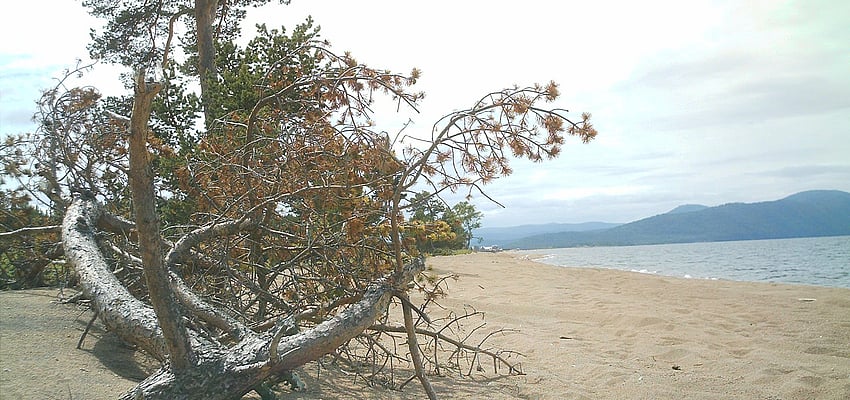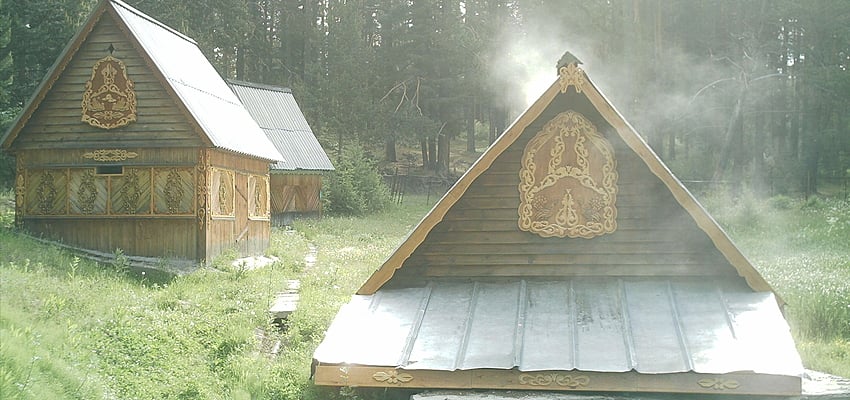


Russia is the biggest country in the world and spreads over two continents, Europe and Asia. It is known for its extreme, hostile, temperatures, but Russia is also a country with vast uninhabited lands, which you can most easily observe during a train trip. If you look at a map of Russia you quickly realise that the European and southern parts are scattered with big towns; the rest of Russia, with its hostile tundra and impossible temperatures, is largely unpopulated.
Most of Russia is covered by plains and plateaux, with a few mountain ranges: the Ural Mountains which mark the border between Europe and Asia, and in the south, the Caucasus, Altai, Sayan and Yablonovy. In the north-east, in Kamchatka, there is a large chain of volcanoes. The south, not far from Mongolia, is delineated by Lake Baikal, a huge lake which has the purest water in the world. The landscape around has allowed it to develop a very interesting micro climate. That said, because of the tectonic plates, this area of Siberia often experiences big earthquakes.
Part of exploring Russia is exploring its many rivers - the Lena, Amur, Yenisei, Angara, Volga...If you like relaxing and are at Lake Baikal you can enjoy the thermal waters in the surrounding area, such as at Archan or Goryachinsk.

Russia also has huge amounts of natural resources. Its soil is full of riches, especially petrol and natural gas. There is also a lot of coal under Russian soil and lots of mines to extract it, making it one of the most attractive employment sectors.
With an extreme continental climate, Russia is known for its rigorously cold winters, which frequently reach -30°C, and in some particularly hostile regions can reach -60°C. Although the cold is extremely difficult it does have some advantages: the ground is always solid and the air is very dry. Little chance of catching cold!
Very cold winters are particularly difficult if you are not used to them. People's habits change, they go out less and walk around less. But the landscapes are incredibly beautiful with snow covered trees, pack ice, and frozen rivers.
In summer the countryside changes, temperatures are much hotter, up to +40°C, and the air stays quite dry. Around Moscow, because of the suffocating heat, there are often fires.
Despite the cold which dominates the country, Russia has several distinct climates which gives regions different geographical particularities, such as taiga, tundra and steppe.
North Russia is characterised by tundra - virgin lands, bare of everything except moss, lichen and heathers. The earth does not encourage trees to grow because it is deep frozen. In this part of Russia, which is extremely cold and sparsely populated, the animals rule - polar bears, seals and reindeer.
In the south, the tundra becomes taiga, with soil that encourages the growth of trees. Immense forests of spruce, larch and pine. Even further south deciduous trees start to appear, like maple, poplar and birch. The birch is the tree that is most representative of the country and lots of crafts products are made from its bark. There are lots of animals in the forest, such as brown bears, deer, boar, and hares, and even lynx and wolves.
Finally, the south of Russia gradually becomes a beautiful steppe, which extends as far as Mongolia.
Some areas of Russia, like Lake Baikal have developed a mirco climate and their own endemic animal and plant life. For example, the nerpa seal in Lake Baikal. It's the only freshwater seal in the world. The lake is also home to fish found nowhere else, such as the Omul which is very prized in Russia.
There are numerous natural parks and reserves in Russia where you can observe interesting natural habitats.